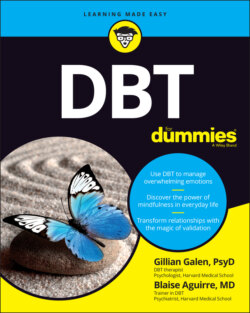Читать книгу DBT For Dummies - Gillian Galen - Страница 97
Understanding Your Behaviors
ОглавлениеIN THIS CHAPTER
Connecting what you feel to how you act
Recognizing and dealing with triggers
Linking specific behaviors to specific reactions
Many of us in the mental health field find human behavior to be fascinating. Observing patterns of behavior and trying to predict what a person is going to do next can be useful in establishing what is helpful and what is not, and what interventions to use if behavior is to be changed. And yet in many instances, behavior is very predictable, because it’s patterned through repetition. Take a behavior like walking. Because of repetition, it’s predictable that a person will walk when getting from point A to point B. And yet walking is a relatively simple behavior. Behaviors that emanate from strong emotions can be very complex and much harder to predict.
People who are emotionally sensitive generally experience life with more intensity than those who are less sensitive. Typically, with more sensitivity comes a greater degree of behavioral variability.
There is nothing problematic with being more emotionally sensitive. Many artists, therapists, actors, musicians, and others recognize that being sensitive is helpful to their craft. However, people who have strong emotions can be at risk of behaving in ways that are dependent on their mood state. Mood-dependent behavior is often what causes people to request DBT therapy for two main reasons: The first is the person doesn’t have the skills to effectively manage emotionally charged situations, and the second is the behavior that happens when a person acts on their feelings or urges without pausing to consider the consequences of the behavior can lead to suffering in the person’s life. Often, mood-dependent behaviors seem automatic and seem to happen quickly, as if the person had no choice. They seem to come from nowhere and appear to be out of an individual’s control, and because of this, they can seem hard to change given the powerful underlying emotions, urges, and often negative thoughts driving them.
In this chapter, we review the connections between feelings and actions, recognize the triggers that set off behaviors, and look at how we can link specific behaviors to specific reactions as a way to begin to change unhelpful behaviors.
